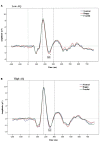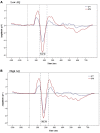Electrophysiological Correlates of Subliminal Perception of Facial Expressions in Individuals with Autistic Traits: A Backward Masking Study
- PMID: 28588465
- PMCID: PMC5440466
- DOI: 10.3389/fnhum.2017.00256
Electrophysiological Correlates of Subliminal Perception of Facial Expressions in Individuals with Autistic Traits: A Backward Masking Study
Abstract
People with Autism spectrum disorder (ASD) show difficulty in social communication, especially in the rapid assessment of emotion in faces. This study examined the processing of emotional faces in typically developing adults with high and low levels of autistic traits (measured using the Autism Spectrum Quotient-AQ). Event-related potentials (ERPs) were recorded during viewing of backward-masked neutral, fearful and happy faces presented under two conditions: subliminal (16 ms, below the level of visual conscious awareness) and supraliminal (166 ms, above the time required for visual conscious awareness). Individuals with low and high AQ differed in the processing of subliminal faces, with the low AQ group showing an enhanced N2 amplitude for subliminal happy faces. Some group differences were found in the condition effects, with the Low AQ showing shorter frontal P3b and N4 latencies for subliminal vs. supraliminal condition. Although results did not show any group differences on the face-specific N170 component, there were shorter N170 latencies for supraliminal vs. subliminal conditions across groups. The results observed on the N2, showing group differences in subliminal emotion processing, suggest that decreased sensitivity to the reward value of social stimuli is a common feature both of people with ASD as well as people with high autistic traits from the normal population.
Keywords: EEG; autism; backward masking; subconscious; subliminal facial emotions.
Figures





Similar articles
-
Event-Related Potential to Conscious and Nonconscious Emotional Face Perception in Females with Autistic-Like Traits.J Clin Med. 2020 Jul 21;9(7):2306. doi: 10.3390/jcm9072306. J Clin Med. 2020. PMID: 32708073 Free PMC article.
-
Autistic traits modulate conscious and nonconscious face perception.Soc Neurosci. 2018 Feb;13(1):40-51. doi: 10.1080/17470919.2016.1248788. Epub 2016 Nov 10. Soc Neurosci. 2018. PMID: 27750521 Free PMC article.
-
Early ERP Modulation for Task-Irrelevant Subliminal Faces.Front Psychol. 2011 May 6;2:88. doi: 10.3389/fpsyg.2011.00088. eCollection 2011. Front Psychol. 2011. PMID: 21687457 Free PMC article.
-
[Neural mechanisms of face recognition: an event-related potential study].Brain Nerve. 2012 Jul;64(7):717-26. Brain Nerve. 2012. PMID: 22764343 Review. Japanese.
-
Distributed and interactive brain mechanisms during emotion face perception: evidence from functional neuroimaging.Neuropsychologia. 2007 Jan 7;45(1):174-94. doi: 10.1016/j.neuropsychologia.2006.06.003. Epub 2006 Jul 18. Neuropsychologia. 2007. PMID: 16854439 Review.
Cited by
-
How ubiquitous is the direct-gaze advantage? Evidence for an averted-gaze advantage in a gaze-discrimination task.Atten Percept Psychophys. 2021 Jan;83(1):215-237. doi: 10.3758/s13414-020-02147-3. Epub 2020 Nov 1. Atten Percept Psychophys. 2021. PMID: 33135097 Free PMC article.
-
Alterations in Rapid Social Evaluations in Individuals with High Autism Traits.J Autism Dev Disord. 2021 Oct;51(10):3575-3585. doi: 10.1007/s10803-020-04795-8. Epub 2021 Jan 4. J Autism Dev Disord. 2021. PMID: 33394240
-
Neurotypicals with higher autistic traits have delayed visual processing of an approaching life-sized avatar's gait: an event-related potentials study.Front Hum Neurosci. 2023 Apr 20;17:1113362. doi: 10.3389/fnhum.2023.1113362. eCollection 2023. Front Hum Neurosci. 2023. PMID: 37151904 Free PMC article.
-
Awareness of Emotional Expressions in Cannabis Users: An Event-Related Potential Study.Front Psychol. 2019 Feb 1;10:69. doi: 10.3389/fpsyg.2019.00069. eCollection 2019. Front Psychol. 2019. PMID: 30774608 Free PMC article.
-
Brain Processes While Struggling With Evidence Accumulation During Facial Emotion Recognition: An ERP Study.Front Hum Neurosci. 2020 Sep 3;14:340. doi: 10.3389/fnhum.2020.00340. eCollection 2020. Front Hum Neurosci. 2020. PMID: 33100986 Free PMC article.
References
-
- American Psychiatric Association (2000). Diagnostic and Statistical Manual of Mental Disorders DSM-IV-TR. Washington, DC: American Psychiatric Association.
-
- American Psychiatric Association (2013). Diagnostic and Statistical Manual of Mental Disorders, 5th Edn. (DSM-5). Arlington, VA: American Psychiatric Association.
LinkOut - more resources
Full Text Sources
Other Literature Sources

